
Hildesheim Cathedral, officially the Cathedral of the Assumption of Mary or simply St. Mary's Cathedral, is a medieval Roman Catholic cathedral in the city centre of Hildesheim, Germany, that serves as the seat of the Diocese of Hildesheim. The cathedral has been on the UNESCO World Cultural Heritage list since 1985, together with the nearby St. Michael's Church because of its unique art and outstanding Romanesque architecture.

Bernward was the thirteenth Bishop of Hildesheim from 993 until his death in 1022.

Münster Cathedral or St.-Paulus-Dom is the cathedral church of the Catholic Diocese of Münster in Germany, and is dedicated to St Paul. It is counted among the most significant church buildings in Münster and, along with the City Hall, is one of the symbols of the city.
St. Bernward's Church is a Catholic church in the city of Hildesheim in Lower Saxony, Germany. The name refers to the bishop Bernward of Hildesheim (960-1022) who was canonized by Pope Celestine III.

The Liuthar Gospels are a work of Ottonian illumination which are counted among the masterpieces of the period known as the Ottonian Renaissance. The manuscript, named after a monk called Liuthar, was probably created around the year 1000 at the order of Otto III at the Abbey of Reichenau and lends its name to the Liuthar Group of Reichenau illuminated manuscripts. The backgrounds of all the images are illuminated in gold leaf, a seminal innovation in western illumination.

The Aachen Cathedral Treasury is a museum of the Roman Catholic Diocese of Aachen under the control of the Cathedral chapter, which houses one of the most important collections of medieval church artworks in Europe. In 1978, the Aachen Cathedral Treasury, along with Aachen Cathedral, was the first monument on German soil to be entered in the List of UNESCO World Heritage Sites. The Treasury contains works from Late Antique, Carolingian, Ottonian, Staufen, and Gothic times. The exhibits are displayed in premises connected to the Cathedral cloisters.
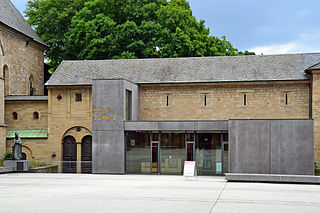
The Essen Cathedral Treasury is one of the most significant collections of religious artworks in Germany. A great number of items of treasure are accessible to the public in the treasury chamber of Essen Minster. The cathedral chapter manages the treasury chamber, not as a museum as in some places, but as the place in which liturgical implements and objects are kept, which continued to be used to this day in the service of God, so far as their conservation requirements allow.

The term Cross of Bernward principally refers to two Ottonian crosses in the cathedral museum in Hildesheim:

The Hildesheim Reliquary of Mary is a historic and artistically unique reliquary in the Dommuseum in Hildesheim. Tradition and legend claims it contained the relic which Emperor Louis the Pious and his party left in the woods or were unable to loosen from a rosebush, as a result of which the Cathedral and diocese are meant to have been established at Hildesheim and dedicated to Mary in 815. Thus, to this day, the reliquary embodies the historical identity and continuity of the diocese. At the ordination of enthronement of a new bishop of Hildesheim, it is presented to them as a special symbol of their solemn reception of the diocese from their predecessor or the Diocesan administrator.

The Hezilo chandelier is an 11th-century Romanesque wheel chandelier. It is part of the treasures of the Hildesheim Cathedral in Hildesheim, Germany, which has been a UNESCO World Cultural Heritage site since 1985. The chandelier was most likely commissioned by Bishop Hezilo of Hildesheim, who rebuilt the cathedral after a fire. He probably also influenced the program of imagery and inscriptions. It is the largest of four extant wheel chandeliers of the period; the others surviving examples are the Azelin chandelier, the Barbarossa chandelier in the Aachen Cathedral, and the Hartwig chandelier in the Abbey of Comburg.

The Azelin chandelier is a Romanesque wheel chandelier, made in the 11th century for the Hildesheim Cathedral in Hildesheim, Germany, a UNESCO World Cultural Heritage site since 1985. It is the oldest of four extant wheel chandeliers from that period, along with the Hezilo chandelier, also in Hildesheim, the Barbarossa chandelier in the Aachen Cathedral, and the Hartwig chandelier in the Abbey of Comburg. It was believed to be donated by Bishop Azelin, however his predecessor Thietmar is more likely to be the patron. Therefore, the chandelier is also called the Thietmar chandelier (Thietmarleuchter).

The Bernward Doors are the two leaves of a pair of Ottonian or Romanesque bronze doors, made c. 1015 for Hildesheim Cathedral in Germany. They were commissioned by Bishop Bernward of Hildesheim (938–1022). The doors show relief images from the Bible, scenes from the Book of Genesis on the left door and from the life of Jesus on the right door. They are considered a masterpiece of Ottonian art, and feature the oldest known monumental image cycle in German sculpture, and also the oldest cycle of images cast in metal in Germany.

The Bernward Column also known as the Christ Column is a bronze column, made c. 1020 for St. Michael's Church in Hildesheim, Germany, and regarded as a masterpiece of Ottonian art. It was commissioned by Bernward, thirteenth bishop of Hildesheim in 1020, and made at the same time. It depicts images from the life of Jesus, arranged in a helix similar to Trajan's Column: it was originally topped with a cross or crucifix. During the 19th century, it was moved to a courtyard and later to Hildesheim Cathedral. During the restoration of the cathedral from 2010 to 2014, it was moved back to its original location in St. Michael's, but was returned to the Cathedral in August 2014.

St. Godehard is a church in Hildesheim, Germany, formerly the church of a Benedictine abbey. It remained almost unaltered through the centuries and was not damaged much in World War II. It is one of the most important examples of Romanesque architecture in Germany.
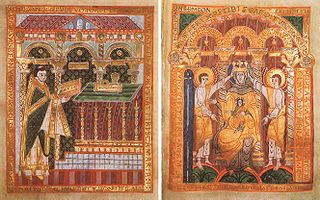
The Rich Bernward Gospels are a richly decorated evangeliary in the Hildesheim Cathedral Museum. It was a donation of Bernward, Bishop of Hildesheim, to his foundation St. Michael's, specifically for the altar to Mary in the crypt below the west choir, which was consecrated in 1015 and which he had designated as his tomb.
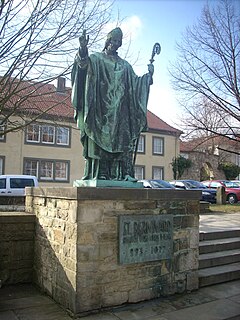
The Bernward Monument is a larger-than-life-sized bronze statue of Bishop Bernward of Hildesheim in the Domhof in Hildesheim. It was made by Ferdinand Hartzer in 1893 for the nine hundredth anniversary of St. Bernward's enthronement as Bishop of Hildesheim. On 7 September 2011, in the course of the renovations of Hildesheim Cathedral it was temporarily relocated to the garden of house 24, Domhof.
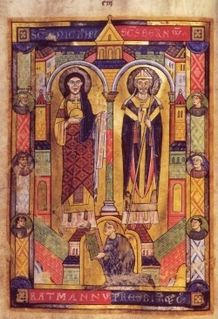
The Ratmann Sacramentary is an illuminated liturgical manuscript, which was produced in 1159 by a monk-priest named Ratmann and given to the cloister of St. Michael's in Hildesheim for the high altar.

A church treasure is the collection of historical art treasures belonging to a church, usually a monastery, abbey, cathedral. Such "treasure" is usually held and displayed in the church's treasury or in a diocesan museum. Historically the highlight of church treasures was often a collection of reliquaries.
The Diocesan museum of Padua displays arts and artifacts belonging to the Roman Catholic Diocese of Padua; it is housed in the 15th-century former bishop's residence or Palazzo Vescovile. The building, adjacent to the Cathedral of Padua, faces the Piazza del Duomo, can in the historic center of Padua, region of Veneto, Italy.
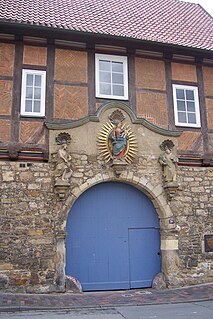
Hildesheim Charterhouse is a former Carthusian monastery or charterhouse in Hildesheim in Lower Saxony, Germany.























